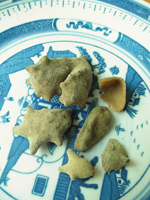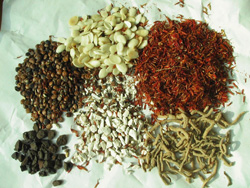|
According to TCM theory, the meridian system is responsible for supplying qi (vital energy) to every part of the body, assisting the distribution of blood and body fluids, maintaining the balance between yin and yang elements, and protecting the body against disease. The twelve regular meridians form the backbone of the meridian system; each of them has branching collaterals that further connect and network throughout the entire body. There are smaller collaterals distributed on the skin surface, which are located on the most superficial part of the body, remedies like hot compresses, dressings and moxibustion can be applied externally based on the distribution of these small collaterals.
Dressing preparation: prepare gallnet of Chinese sumac (24g) and cassia twig (11g), grind and mix them.
Method: take 3.5g of the mixture and add vinegar to make into a paste, put it at the center of the soles of the feet, covered by gauze or tape for overnight. Apply three times. This helps relieve night sweating in menopause.
 |
| Gallnet of Chinese Sumac |
1. Umbilical remedies
In TCM, the umbilicus (also called the navel or belly button) is known as shen que (Cv 8), which is an important acupoint along the Conception Vessel Meridian. It has a close relationship with the physiology and pathology of the internal organs, limbs and bones. By stimulating the umbilicus, a medicinal effect infiltrates through the skin and reaches the meridians, activating qi movement and promoting internal balance. An umbilical dressing is an important external therapy in TCM. Physicians prescribe herbs after a detailed consultation with an individual and deliver them to the patient into creams, granules, pills, powder and soft extracts. The drug is pasted onto the navel and covered by gauze or tape. Occasionally, TCM physicians will combine this with moxibustion or a hot compress.
a) Moxibustion protocol for general bodily enhancement
Dressing preparation: prepare an equal amount of rehmannia root, cistanche, dodder seed and cornus fruit, grind together and then combine with equal amount of salt.
Method: fill the navel with the mixture, place a lit moxa cone on it, this will make the region warm. If moxibustion boxes are available, just burn 0.1g of loose moxa in a box. Apply it once a day, 4 weeks being one course.
b) Dressing for hot flashes and sweating
Dressing preparation: red sage root, schisandra and tuber fleeceflower stem 5g each; rehmannia root and lily bulb 30g each; shriveled wheat 80g. Grind and mix them.
Methods: add wine to make the mixture into a paste, every night fill in the navel and then covered by gauze or tape. Do this every day.
c) Dressing for insomnia and sweating
Dressing preparation: ledebouriella root, ephedra root, largehead atractylodes rhizome, liquorice root (processed with honey), 20g each; astragalus root and shriveled wheat 60g each; schisandra 30g. Grind and mix them.
Method: add honey to make the mixture in paste form, every night fill in the navel and then covered by gauze or tape. Do this every day.
2. Medicinal Pillows
In ancient China, pillows were made with various materials, besides the usual materials like cotton and silk, stone, jade, crystals and wood were also popular. Some pillows were specially stuffed with herbs for healing and wellness purposes. The theory behind is that the head is regarded as "the house of essential substance" in TCM, essence from the organs are gathered there, and blood and qi (vital energy) always flow through it. Thus, the head serves as the highest center for regulating functions inside the body. Since we spend one third a day sleeping on a pillow, medicinal pillows can make the properties of herbs enter through the head. The selected herbs are mostly aromatic, which help tranquilize, refresh and dilate the local blood vessels leading to harmonize the internal environment.
Various herbs are stuffed in the pillows and can be used for dizziness, poor memory, ear ringing, blurred version, anxiety, facial paralysis due to strokes, shoulder pain and jaw pain. It also has been reported that these pillows are also effective for headache, insomnia, hypertension and neck problems. For menopause, a pillow can be prepared using the method described below:
Herbal prescription: poria, bamboo leaf, common rush and rose bud, 50g of each; chrysanthemum and gambir vine stem 80g of each; amber 20g and peppermint 30g.
Method: grind the herbs slightly and wrap them in a stuffing pillow pad, every night heat it up before sleep on it. It can be used for one month.
3. Herbal foot baths
Chinese herbal baths are generally indicated for various conditions. In TCM, the feet are the start of the three yin meridians and the end of the three yang meridians with more than sixty acupoints below the ankles. Bathing the feet regularly can stimulate the acupoints, activate the flows in the meridians, and thus enhance body functioning. Selection of herbs is usually based on specific conditions. For menopause, physicians aim to activate the blood and promote a calming effect.
Herbal prescription: polygala root and Chinese safflower 9g each; sour jujube seed, magnetite, fossil bone and peach kernel 15g each.
Methods: boil herbal decoction in an amount sufficient to cover ankles; keep the water temperature between 50-60óJ, and soak for at least 30 minutes, while rubbing the feet softly for a better result. After bathing, wipe the feet thoroughly, keep warm and avoid wind; raise the feet and rest for 15 to 30 minutes. Do this before sleeping every night, 15 days is one course. This is not suitable for people who have effusion or infections on their feet.
 |
| Herbal prescription for foot bath |
|